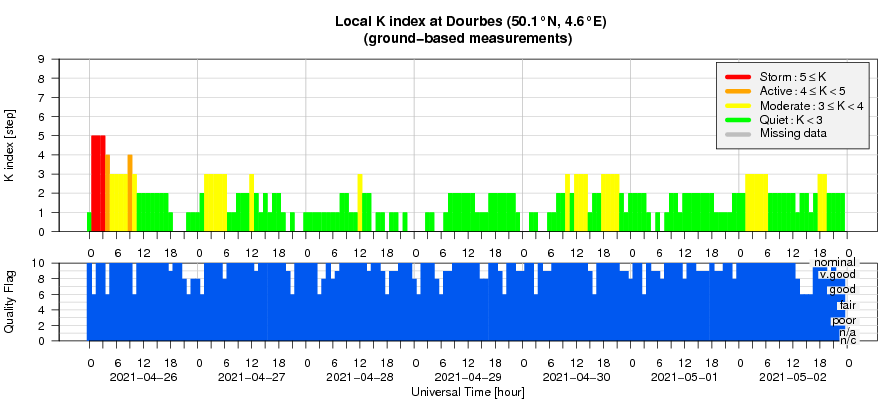- Table of Content
- 1.Quo Vadis disc...
- 2.Call for nomin...
- 3.Review of sola...
- 4.PROBA2 Observa...
- 5.The Internatio...
- 6.Review of geom...
- 7.Geomagnetic Ob...
- 8.The SIDC Space...
- 9.Review of iono...
2. Call for nominations: international space weather and space climate medals 2021
3. Review of solar activity
4. PROBA2 Observations (26 Apr 2021 - 2 May 2021)
5. The International Sunspot Number by Silso
6. Review of geomagnetic activity
7. Geomagnetic Observations at Dourbes (26 Apr 2021 - 2 May 2021)
8. The SIDC Space Weather Briefing
9. Review of ionospheric activity (26 Apr 2021 - 2 May 2021)
Quo Vadis discussion forum
SUMMARY: Following up on its 17 March 2021 kick-off meeting (https://www.stce.be/news/516/welcome.html ), the Quo Vadis ESWC interim board now invites you to its discussion forum.
We invite you to a discussion on the future of space weather in Europe.
This discussion follows a white paper (https://www.swsc-journal.org/articles/swsc/pdf/2021/01/swsc200098.pdf). Since it was published, an online event 'Quo Vadis European Space Weather Community' was organised on March 17 2021. A "Quo Vadis Interim Board" was then set up, at the origin of this invitation. The discussion will go on until June 21st.
The Interim Board is composed by volunteers from the community in Europe. Its role is to coordinate the efforts so that the space weather European community can
1) Organize itself
2) Elect people to represent them.
To reach this goal, the Interim Board is inviting anyone interested in and outside Europe to join the "Quo Vadis European Space Weather Community " discussion forum.
Eligible European Space Weather Community members should register to the "Electoral Census" to be able to vote in June for the final choice of organisation.
This effort will be achieved through different actions indicated on the webpage at https://quovadis.aeronomie.be/index.php and in a special Slack workspace.

Call for nominations: international space weather and space climate medals 2021
Dear colleagues,
We are happy to announce the 2021 contest for the international space weather and space climate medals. The new medal recipients will be announced in a medal ceremony at the European Space Weather Week, October 25th, 2021. The winners will be proposed an invited 20 minutes lecture during a dedicated session.
Please, find all information on how to nominate a colleague at http://esww17.iopconfs.org/medals
The deadline for the nominations is September, 5th 2021.
All three prizes are prestigious recognitions of recipients' major contributions in the field of space weather. Medal recipients' work must have been documented in peer review journals or book chapters, or must be a technological contribution that has led to a fully implemented new space weather capability. Medal recipients' work must be relevant to space weather and/or space climate. The work must also be internationally recognized.
In addition to the above common criteria, there are the following specific requirements for each of the three medals:
The Kristian Birkeland Medal for Space Weather and Space Climate
The recipient of the Kristian Birkeland Medal must have demonstrated a unique ability to combine basic and applied research to develop useful space weather products that are being used outside the research community, and/or across scientific research disciplines. The work must have led to a better physical comprehension of the solar-terrestrial phenomena related to space weather, to a drastic improvement of space weather modeling, or to a new generation of instruments.
The Baron Marcel Nicolet Medal for Space Weather and Space Climate
The recipient of the Baron Marcel Nicolet Medal must have demonstrated a unique ability to bind the space weather community in a spirit of peace and friendship, to educate within the space weather community, to go also beyond the space weather research community and address larger audiences, and/or to serve the space weather.
The Alexander Chizhevsky Medal for Space Weather and Space Climate
The Alexander Chizhevsky Medal is awarded to an early career scientist in recognition of outstanding achievements in space weather with an innovative approach. The nominee must be an early career scientist within 8 years of receiving their Ph.D. at the time of nomination. The period may be increased to include the duration any parental leave after their Ph.D.
The Medal Committee
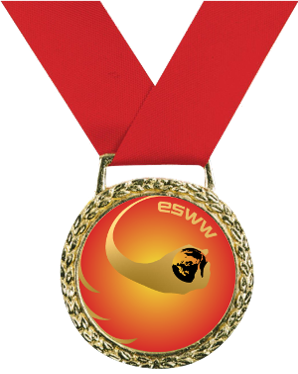
Review of solar activity
NOAA region 2816 produced the only C flare of the week while it was decaying into a plage early in the week. Also NOAA region 2819 decayed early in the week while the unipolar region NOAA 2818 has been stable all week. But the most important regions were just to the South of NOAA 2818, where we had the bipolar region NOAA 2820 which was accompanied early in the week by a newly emerging bipolar region NOAA 2821 just to the West of NOAA 2820. These two regions were responsible for several B flares. By the end of the week these two regions decayed and all regions rotated of the visible disk.
A filament in the South-Eastern quadrant erupted on April 25. The resulting CME was directed too far East to have any impact on Earth.
On April 25, more CME signatures on the Western side were seen, although the CMEs were difficult to separate and to connect to Solar surface activity. However, STEREO COR2 images gave a clearer view of the CME directed towards the West (from STEREO perspective). The onset time of the slow CMEs was thought to be 18UT April 25. The ejecta were expected to be associated with a field reconfiguration to the South-West of the newly emerged region NOAA 2820, where also dimmings could be seen around this time.
A second long filament stretching across the central meridian in the Southern hemisphere erupted around 13:00UT April 26. This could be seen in SDO/AIA 304 images. An associated Westward (from STEREO A perspective) CME was seen from around 20:24UT in STEREO A COR2 images. In SoHO/LASCO coronagraph images a faint Southward cloud was seen at 23:12 UT.
A positive polarity coronal hole in the Northern hemisphere crossed the central meridian April 27-29. Another positive polarity coronal hole in the Southern hemisphere crossed the central meridian on April 30/May 1.
The greater than 10 MeV proton flux was at nominal levels the entire week.
The greater than 2 MeV electron flux briefly touched or exceeded shortly the 1000 pfu event threshold a few times. The 24h electron fluence was mostly at normal levels but slightly elevated in the middle of the week following the solar wind enhancements of early in the week.
PROBA2 Observations (26 Apr 2021 - 2 May 2021)
Solar Activity
Solar flare activity fluctuated from very low to low during the week.
In order to view the activity of this week in more detail, we suggest to go to the following website from which all the daily (normal and difference) movies can be accessed: https://proba2.oma.be/ssa
This page also lists the recorded flaring events.
A weekly overview movie can be found here (SWAP week 579). https://proba2.sidc.be/swap/data/mpg/movies/weekly_movies/weekly_movie_2021_02_08.mp4
Details about some of this week's events can be found further below.
If any of the linked movies are unavailable they can be found in the P2SC movie repository here https://proba2.oma.be/swap/data/mpg/movies/
Friday April 30
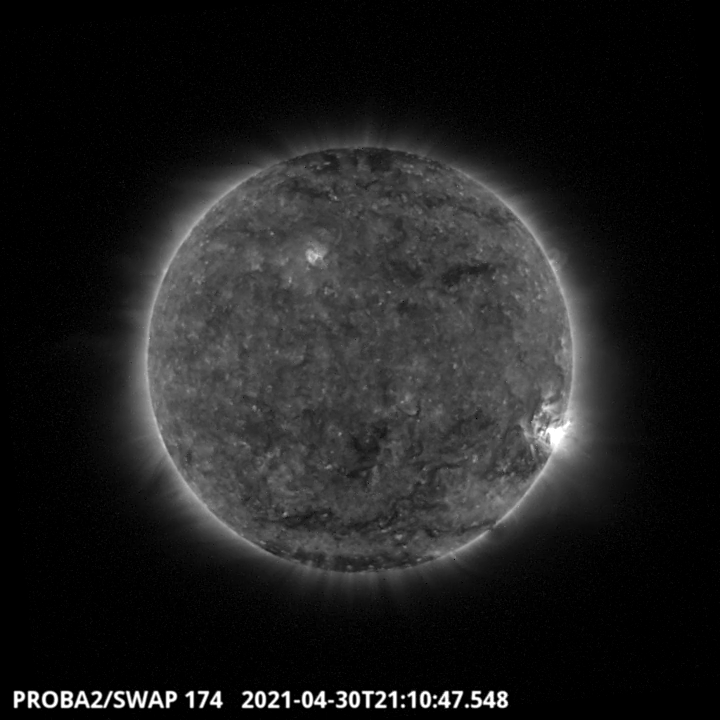
A coronal hole in the Southern hemisphere crossed the central meridian on April 30 and May 1. Find a movie of the events here (SWAP movie) http://proba2.oma.be/swap/data/mpg/movies/20210430_swap_movie.mp4
Monday May 01
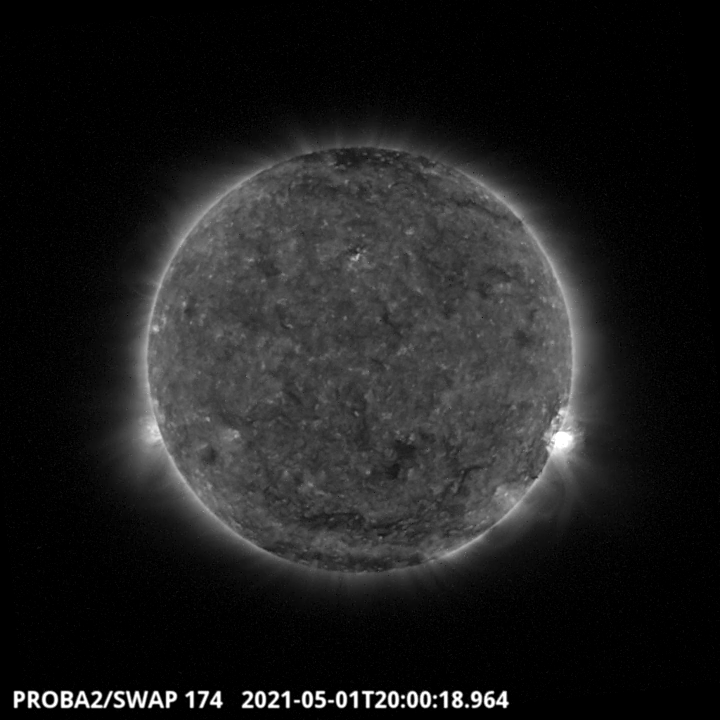
A flow is visible on the South-East part of the solar disk around 20:00 UT on the SWAP image above. It was associated to a B1.7 event, originating from the NOAA active region 2820. This active region gave rise to more than ten B class flares during this week. Find a movie of the events here (SWAP movie) http://proba2.oma.be/swap/data/mpg/movies/20210501_swap_movie.mp4
The International Sunspot Number by Silso
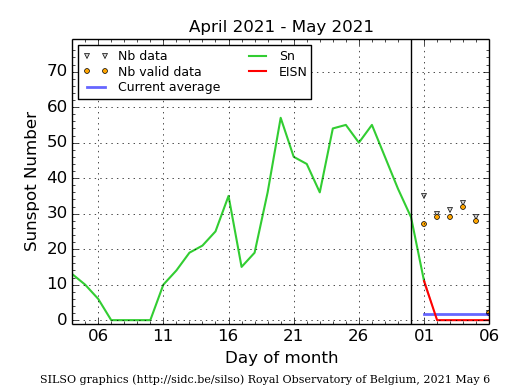
The daily Estimated International Sunspot Number (EISN, red curve with shaded error) derived by a simplified method from real-time data from the worldwide SILSO network. It extends the official Sunspot Number from the full processing of the preceding month (green line), a few days more than one solar rotation. The horizontal blue line shows the current monthly average. The yellow dots gives the number of stations that provided valid data. Valid data are used to calculate the EISN. The triangle gives the number of stations providing data. When a triangle and a yellow dot coincide, it means that all the data is used to calculate the EISN of that day.
Review of geomagnetic activity
Solar wind started the week in a fast regime with speeds around 500 km/s which persisted to late April 27. By afternoon April 29, the speed returned to the slow regime, just over 300 km/s.
Some solar wind transients, probably related to the April 25 and 26 CMEs were visible in the data. A very weak fast forward shock, measured by DSCOVR on 18:44UT April 29, indicated the presence of a structure in the solar wind.
Solar wind speed varied in the remainder of the week between 300-400 km/s. Total magnetic field was in that period slightly enhanced but never really over 10 nT.
A magnetic field rotation can be identified on May 2.
Geomagnetic conditions reached minor storm levels (local K Dourbes and NOAA Kp 5). This was linked to the high speed stream in the beginning of the week. The conditions became quiet to unsettled as soon as the high speed stream had passed.
The SIDC Space Weather Briefing
The Space Weather Briefing presented by the forecaster on duty from April 25 to May 2. It reflects in images and graphs what is written in the Solar and Geomagnetic Activity report.

A pdf-version: https://www.stce.be/briefings/20210503_SWbriefing.pdf
The movie: https://www.stce.be/briefings/20210503_SWbriefing.m4v
Review of ionospheric activity (26 Apr 2021 - 2 May 2021)
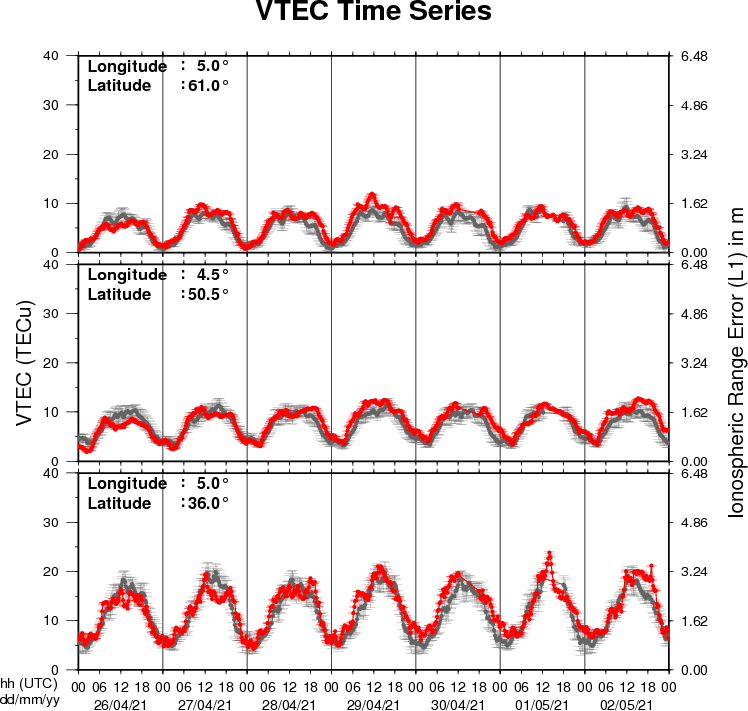
The figure shows the time evolution of the Vertical Total Electron Content (VTEC) (in red) during the last week at three locations:
a) in the northern part of Europe(N61°, 5°E)
b) above Brussels(N50.5°, 4.5°E)
c) in the southern part of Europe(N36°, 5°E)
This figure also shows (in grey) the normal ionospheric behaviour expected based on the median VTEC from the 15 previous days.
The VTEC is expressed in TECu (with TECu=10^16 electrons per square meter) and is directly related to the signal propagation delay due to the ionosphere (in figure: delay on GPS L1 frequency).
The Sun's radiation ionizes the Earth's upper atmosphere, the ionosphere, located from about 60km to 1000km above the Earth's surface.The ionization process in the ionosphere produces ions and free electrons. These electrons perturb the propagation of the GNSS (Global Navigation Satellite System) signals by inducing a so-called ionospheric delay.
See http://stce.be/newsletter/GNSS_final.pdf for some more explanations ; for detailed information, see http://gnss.be/ionosphere_tutorial.php
